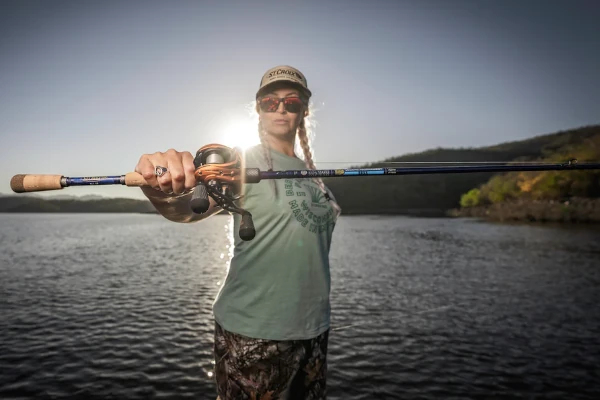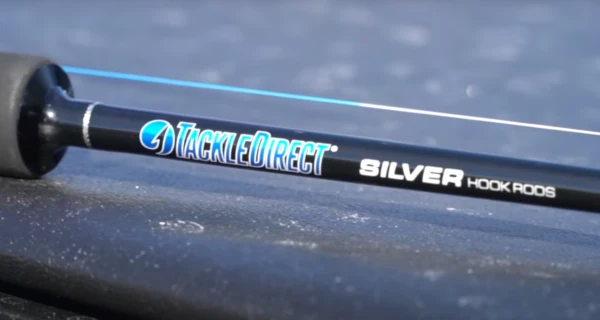What's Better: Fiberglass, Graphite, Carbon, or Composite Fishing Rods?
Posted by TackleDirect on Sep 14th 2023

Should you get a fiberglass, graphite, carbon fiber, or composite rod? TackleDirect compares these three popular rod types to see what’s best for your angling adventures.
Understanding the Basics of Rod Materials
Fishing, for many, is not just a hobby; it's a passion, a way to connect with nature, and a means to challenge one's skills against the elusive aquatic creatures. Whether you're a seasoned angler or just dipping your toes into the world of fishing, choosing the right fishing rod is paramount to your success.
There's a plethora of options available, but fishing rods can generally be categorized into four main types: fiberglass, graphite, carbon fiber, and composite fishing rods. In this comprehensive guide, we'll delve deeper into each of these rod types to help you make an informed decision for your angling adventures.
Fiberglass Fishing Rods: A Time-Tested Classic
Fiberglass fishing rods have a long-standing history in the angling world. Introduced in the 1940s, they quickly gained popularity and remained a staple for decades, especially among beginners. There are several reasons why fiberglass fishing rods continue to be a favorite choice for many anglers.
Of the modern fishing rod materials, lightweight fiberglass is the most affordable and requires the least maintenance. Fiberglass is very durable yet flexible for better drag and less chance of tearing through soft-mouth fish. The slower action is more forgiving and helps when setting a hook on larger game.
However, there are some downsides to fiberglass rods. They tend to lack sensitivity, making it challenging to detect subtle bites. Additionally, they don't possess as much power as graphite or composite rods, making them better suited for small to medium bodies of water where long-distance casting accuracy is not as critical.

Fiberglass Rod :
St. Croix Legend Glass Casting Rods
Pros of Fiberglass Blanks:
- Affordability: Fiberglass rods are often the most budget-friendly option, making them accessible to beginners and anglers on a tight budget.
- Durability: They are highly durable and can withstand rough handling and abuse, making them suitable for beginners and tough fishing conditions.
- Forgiving Action: Fiberglass rods have a slower action, making them forgiving when setting the hook, especially for larger fish.
- Flexibility: Their flexibility reduces the chance of tearing through the soft mouths of some fish species.
Cons of Fiberglass Blanks:
- Lack of Sensitivity: Fiberglass rods are less sensitive, making it challenging to detect subtle bites.
- Limited Power: They generally lack the power and strength of graphite or composite rods.
- Accuracy: Fiberglass rods may not be as accurate on long casts, limiting their suitability for certain fishing scenarios.
Graphite Fishing Rods: Precision and Sensitivity
Graphite fishing rods, on the other hand, have become the preferred choice for many professional anglers, especially those seeking more action and sensitivity in their equipment. Although they were first introduced in the 1960s, they didn't gain widespread popularity until the 1980s.
Graphite rods are slightly lighter than fiberglass yet are still durable, holding up to large fish and brutal weather with ease. The super-sensitive feel gives the angler more control, and the cast is remarkably accurate at any distance.
However, graphite blanks aren’t very flexible, so you need to get the timing just right when setting a hook. This also makes the rod more brittle and more prone to snap from a strong fish or getting caught on rocks and branches. Finally, a graphite fishing rod is typically more expensive than a fiberglass rod. As such, while graphite rods do well in experienced hands, they might not be right for new anglers.

Graphite Rod :
G Loomis IMX-Pro Blue Saltwater Rods
Pros of Graphite Blanks:
- Lightweight: Graphite rods are lighter than their fiberglass counterparts, which can reduce angler fatigue during long casting sessions.
- Sensitivity: Graphite's inherent stiffness provides exceptional sensitivity. Anglers can feel even the slightest nibble, giving them an edge when it comes to detecting bites.
- Accuracy: Graphite rods excel in accuracy, allowing anglers to cast with precision at various distances.
- Professional Choice: They are favored by many professional anglers for their performance and sensitivity.
Cons of Graphite Blanks:
- Brittleness: Graphite rods can be more brittle and prone to snapping when subjected to strong forces or obstacles.
- Higher Cost: They are generally more expensive than fiberglass rods, which may not be suitable for anglers on a tight budget.
- Less Forgiving: Due to their stiffness, graphite rods are less forgiving when setting the hook, requiring precise timing.
Carbon Fiber Fishing Rods: Strength and Performance
Carbon fiber fishing rods have gained popularity in recent years due to their remarkable strength-to-weight ratio and advanced technology. These rods are often favored by anglers who demand precision and performance in their equipment.
Carbon fiber rods are celebrated for their exceptional sensitivity, allowing anglers to detect even the faintest of bites. Their lightweight construction reduces fatigue during extended casting sessions, and they excel in casting accuracy, making them ideal for targeting specific fish or fishing in tight spaces.
While carbon fiber rods offer impressive sensitivity and strength, they are not without their drawbacks. Their inherent stiffness and lack of forgiveness can make them less suitable for novice anglers who may struggle with the precise timing required for hook sets. Furthermore, carbon fiber rods can be more brittle, making them susceptible to snapping when faced with strong forces or unexpected obstacles. Carbon rods also tend to be relatively expensive.

Carbon Fiber Rod :
St. Croix Legend Tournament Bass Casting Rods
Pros of Carbon Fiber Blanks:
- Exceptional Sensitivity: Carbon fiber rods are renowned for their outstanding sensitivity, allowing anglers to detect even the most subtle of bites. This heightened sensitivity can significantly improve your chances of hooking elusive fish.
- Lightweight: Carbon fiber is incredibly lightweight, reducing angler fatigue during long casting sessions. This characteristic makes them an excellent choice for anglers who spend extended periods on the water.
- Precision Casting: These rods excel in accuracy, providing anglers with the ability to cast with precision at varying distances. This precision can be particularly advantageous when targeting specific fish or fishing in tight spaces.
- Strength and Durability: Carbon fiber rods are known for their strength and durability, making them capable of handling large, powerful fish and challenging fishing conditions.
- Minimal Maintenance: Carbon fiber is resistant to corrosion and does not require as much maintenance as some other rod materials, making them a low-maintenance option for anglers.
Cons of Carbon Fiber Blanks:
- Cost: Carbon fiber rods tend to be on the more expensive side, which can be a limiting factor for anglers on a tight budget. The advanced technology and materials used in their construction contribute to their higher price tag.
- Brittleness: While carbon fiber is strong, it can also be brittle. These rods may be more prone to snapping if subjected to strong forces, such as when battling exceptionally large fish or getting caught on underwater obstacles.
- Limited Forgiveness: Carbon fiber rods are less forgiving when setting the hook, requiring precise timing and finesse. This characteristic can be challenging for beginners who are still honing their angling skills.
Composite Fishing Rods: Finding the Middle Ground
Composite fishing rods offer a unique blend of materials to provide the benefits of both fiberglass and graphite. Most composite rods incorporate a mix of fiberglass and graphite and sometimes include other fibers like carbon.
By blending materials, composite rods are the most versatile and frequently the easiest to use. They generally offer a "middle ground" in terms of sensitivity, power, accuracy, strength and price. While most have medium or medium-fast action, each manufacturer has their own design, giving you choices when you shop.
While composite rods offer a compelling blend of features, they do have limitations. They might not perform as well as pure graphite rods in extreme conditions, where maximum power and sensitivity are required. Additionally, they may not be as forgiving on rough bottoms as fiberglass blanks. Nevertheless, they are an excellent choice for intermediate anglers or those seeking a versatile all-around rod that can handle various fishing scenarios.

Composite Rod :
TackleDirect Silver Hook Series Boat Spinning Rod
Pros of Composite Blanks:
- Versatility: Composite rods offer a balanced blend of sensitivity, power, accuracy, strength, and price, making them versatile for various fishing scenarios.
- Customization: Different manufacturers produce composite rods with unique designs, providing anglers with a range of options.
- Balanced Performance: They provide a middle ground in terms of sensitivity, power, and accuracy, suitable for a wide range of anglers.
Cons of Composite Blanks:
- Not Ideal for Extreme Conditions: They may not perform as well as pure graphite rods in extreme conditions that demand maximum power or sensitivity.
- Limited Power: Composite rods may not have as much power as pure graphite or fiberglass rods.
- Less Forgiving than Fiberglass: They might not be as forgiving on rough bottoms as pure fiberglass rods.
Choosing the Right Rod for You
Ultimately, the choice between fiberglass, graphite, carbon fiber, or composite fishing rods boils down to your individual preferences, fishing style, and budget. Here are some considerations to help you make an informed decision:
Experience Level: If you're new to fishing, a fiberglass rod's forgiving nature might be the best choice to start with. Experienced anglers who value sensitivity and precision might lean towards graphite, carbon fiber, or composite rods.
Fishing Conditions: Consider the type of water bodies you'll be fishing in. Fiberglass rods are well-suited for smaller bodies of water, while graphite or composite rods excel in various conditions, including larger lakes and rivers.
Budget: Your budget will also play a significant role in your decision. Fiberglass rods are the most budget-friendly, while graphite rods tend to be more expensive. Carbon fiber rods run on the higher end of the scale. Composite rods provide a balance between performance and cost.
Fishing Goals: Think about your angling goals. Are you looking to specialize in a particular type of fishing, or do you want a versatile rod that can handle a variety of situations? This can influence your choice of rod material and action.
In conclusion, the choice between fiberglass, graphite, composite, and carbon fiber fishing rods is not a one-size-fits-all decision. Each material has its own set of advantages and drawbacks, and the right choice depends on your unique needs and preferences as an angler. Regardless of your choice, investing in a high-quality fishing rod that suits your style will undoubtedly enhance your angling adventures and increase your chances of success on the water.
Happy fishing!


